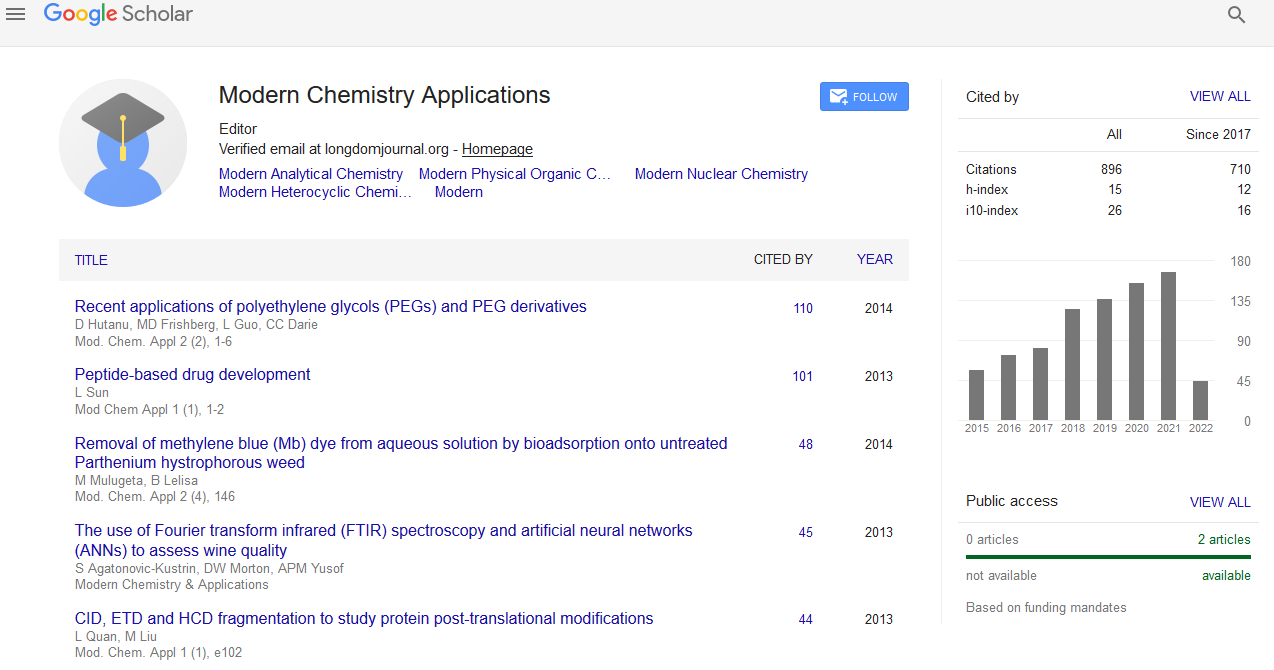Indexed In
- Open J Gate
- JournalTOCs
- RefSeek
- Hamdard University
- EBSCO A-Z
- OCLC- WorldCat
- Scholarsteer
- Publons
- Geneva Foundation for Medical Education and Research
- Google Scholar
Useful Links
Share This Page
Journal Flyer

Open Access Journals
- Agri and Aquaculture
- Biochemistry
- Bioinformatics & Systems Biology
- Business & Management
- Chemistry
- Clinical Sciences
- Engineering
- Food & Nutrition
- General Science
- Genetics & Molecular Biology
- Immunology & Microbiology
- Medical Sciences
- Neuroscience & Psychology
- Nursing & Health Care
- Pharmaceutical Sciences
Short Communication - (2024) Volume 12, Issue 3
Green Chemistry: Innovations for a Sustainable Future
Albert Zink*Received: 23-Aug-2024, Manuscript No. MCA-24-27448; Editor assigned: 26-Aug-2024, Pre QC No. MCA-24-27448 (PQ); Reviewed: 10-Sep-2024, QC No. MCA-24-27448; Revised: 17-Sep-2024, Manuscript No. MCA-24-27448 (R); Published: 26-Sep-2024, DOI: 10.35248/2157-7560.24.12.479
Description
There has never been a greater need for creative approaches to chemistry as the world faces severe environmental issues including resource depletion and climate change. At the front of this trend is green chemistry, a discipline devoted to creating chemical reactions and products with the least possible negative effects on the environment. Green chemistry aims to improve the efficiency and safety of chemical operations while simultaneously lowering pollution by incorporating sustainability ideas into the chemical sector.
Principles of green chemistry
Twelve core concepts developed by Paul Anastasia and John Warner in the late 1990s serve as the foundation for green chemistry [1]. These guidelines promote a comprehensive approach to chemical research and manufacturing, pushing chemists to think about how their work may affect the environment and human health at every turn. Instead than handling garbage after it has been produced, one of the main objectives of waste prevention is to build procedures that minimize waste [2]. This change in viewpoint encourages creative thinking on ways to lessen chemical reaction byproducts. The Atom Economy idea promotes the maximum possible integration of all process elements into the finished product. High atom economy improves the sustainability of chemical reactions and lowers waste production. The goal of safer chemicals is to create non-toxic goods that don't endanger the environment or human health. This idea promotes the creation of safer substitutes for dangerous materials. Efficiency of energy Green chemistry highlights the need for energy-efficient processes, which frequently result in lower expenses and smaller carbon footprints. Feedstock’s that is renewable: Sustainability depends on using renewable resources like plant-based materials instead of finite fossil fuels [3]. This idea promotes the creation of bioprocesses that make use of renewable resources. These ideas form the basis for advancements in a number of fields, such as materials science, agriculture and pharmaceuticals. Chemists can contribute to the development of a more sustainable future by putting these ideas into practice [4].
Innovations driven by green chemistry
The promise of green chemistry to produce sustainable solutions has been demonstrated by the notable advancements it has brought about in a variety of industries [5].
Pharmaceuticals: It frequently uses dangerous chemicals and produces large amounts of waste, the pharmaceutical business is well known for its negative effects on the environment [6]. However, more environmentally friendly methods of medication development have been made possible by green chemistry. The application of flow chemistry, which permits continuous production processes, is one noteworthy development. In addition to cutting waste, this method increases the effectiveness of chemical reactions, which raises yields and uses less energy. Furthermore, hazardous solvents that were once employed in medication manufacturing have been replaced by "green solvents," such as water and bio-based solvents. For instance, cleaner extraction procedures are made possible by the use of supercritical carbon dioxide as a solvent, which eliminates the need for organic solvents that may be hazardous to human health and the environment. These developments improve the safety of pharmaceutical manufacturing while also reducing their negative effects on the environment [7].
Agriculture: Green chemistry is essential to the development of sustainable agricultural practices that lessen dependency on chemical pesticides and fertilisers. This strategy is demonstrated by the development of bio-pesticides made from natural sources [8]. These substitutes successfully manage pests while frequently posing less of a threat to non-target species, such as humans and beneficial insects. Furthermore, controlled-release fertilisers, which release nutrients gradually and lower the risk of runoff and environmental pollution, have been developed thanks to green chemistry. These fertilisers promote healthier soils and more sustainable farming methods by increasing nutrient efficiency.
Challenges and future directions
Green chemistry has advanced, yet there are still issues. The requirement for broad acceptance in the chemical sector is one major obstacle. Making the switch from conventional to green operations frequently necessitates a large financial outlay as well as a change in perspective among industry participants [9]. Furthermore, in order to promote the adoption of sustainable practices, legislative frameworks and financial incentives must coincide. Awareness and education are also essential. The next generation of chemists can be motivated to give sustainability top priority in their research and practices by incorporating green chemistry concepts into academic courses. Furthermore, encouraging cooperation between government, business, and academia helps hasten the creation and application of green technologies [10].
Conclusion
Green chemistry, which unites scientific innovation with environmental care, is a revolutionary approach to chemical research and industrial practices. The chemical business can lessen its environmental impact while still meeting societal demands by upholding its values. Green chemistry has the ability to produce sustainable solutions that benefit both people and the environment, as demonstrated by developments in the fields of agriculture and pharmaceuticals. It is impossible to overestimate the significance of green chemistry in light of the growing complexity of our environmental problems. Prioritizing sustainability and making active investments in the creation of more environmentally friendly technology are crucial for academics, businesses, and legislators. Through the adoption of green chemistry principles, we may create a sustainable future in which chemistry enhances rather than diminishes the earth. In addition to being necessary, the transition to a more sustainable chemical sector offers a chance to rethink our connection with the environment and create a healthier planet for future generations.
References
- Crawford SE, Hartung T, Hollert H, Mathes B, van Ravenzwaay B, Steger-Hartmann T, et al. Green toxicology: A strategy for sustainable chemical and material development. Environ Sci Eur. 2017;29:1-6.
[Crossref] [Google Scholar] [PubMed]
- Al Masud MA, Shin WS, Sarker A, Septian A, Das K, Deepo DM, et al. A critical review of sustainable application of biochar for green remediation: Research uncertainty and future directions. Sci Total Environ. 2023:166813.
[Crossref] [Google Scholar] [PubMed]
- Makhija R, Barik P, Mehta A, Ganti SS, Asati V. Sustainable approaches to analyzing phenolic compounds: A green chemistry perspective. Anal Sci. 2024;40(11):1947-1968.
[Crossref] [Google Scholar] [PubMed]
- Vargas JA, Mandrekar K, Echemendía R, Burtoloso AC. Innovations in Isocyanate Synthesis for a Sustainable Future. Org Biomol Chem. 2024.
[Crossref] [Google Scholar] [PubMed]
- Bognár S, Putnik P, Šojić Merkulov D. Sustainable green nanotechnologies for innovative purifications of water: Synthesis of the nanoparticles from renewable sources. Nanomaterials. 2022;12(2):263.
[Crossref] [Google Scholar] [PubMed]
- Berdimurodov E, Eliboyev I, Berdimuradov K, Kholikov A, Akbarov K, Dagdag O, et al. Green β-cyclodextrin-based corrosion inhibitors: Recent developments, innovations and future opportunities. Carbohydr Polym. 2022;292:119719.
[Crossref] [Google Scholar] [PubMed]
- Maertens A, Luechtefeld T, Knight J, Hartung T. Alternative methods go green!: Green toxicology as a sustainable approach for assessing chemical safety and designing safer chemicals. ALTEX.
[Crossref] [Google Scholar] [PubMed]
- Chen TY, Hsiao YW, Baker-Fales M, Cameli F, Dimitrakellis P, Vlachos DG, et al. Microflow chemistry and its electrification for sustainable chemical manufacturing. Chem Sci. 2022;13(36):10644-10685.
[Crossref] [Google Scholar] [PubMed]
- Saratale GD, Banu JR, Nastro RA, Kadier A, Ashokkumar V, Lay CH, et al. Bioelectrochemical systems in aid of sustainable biorefineries for the production of value-added products and resource recovery from wastewater: A critical review and future perspectives. Bioresour Technol. 2022;359:127435.
[Crossref] [Google Scholar] [PubMed]
- Dubey RK, Shukla S, Hussain Z. Green synthesis of silver nanoparticles; A Sustainable approach with diverse applications. Chinese Journal of Applied Physiology. 2023:e20230007.
[Crossref] [Google Scholar] [PubMed]
Citation: Zink A (2024). Green Chemistry: Innovations for a Sustainable Future. Modern Chem Appl. 12:479.
Copyright: © 2024 Zink A. This is an open access article distributed under the terms of the Creative Commons Attribution License, which permits unrestricted use, distribution, and reproduction in any medium, provided the original author and source are credited.


